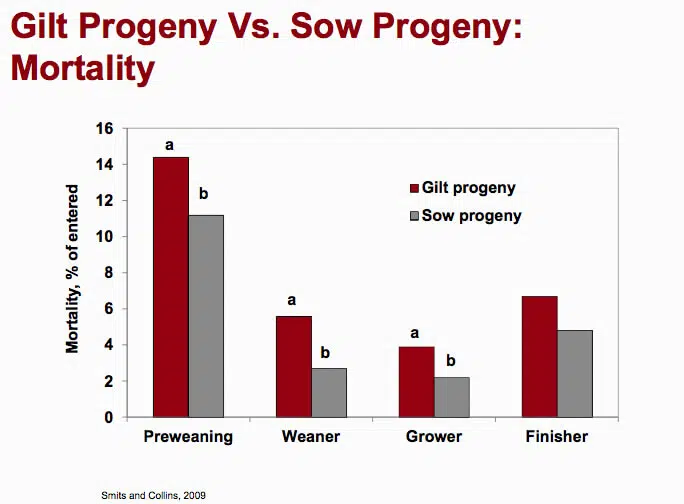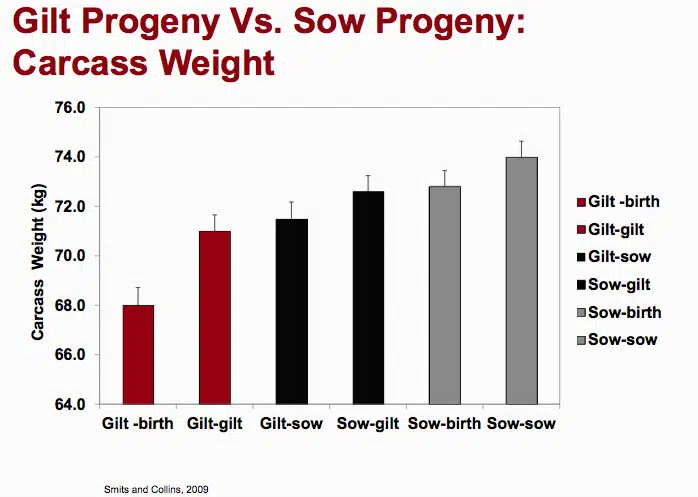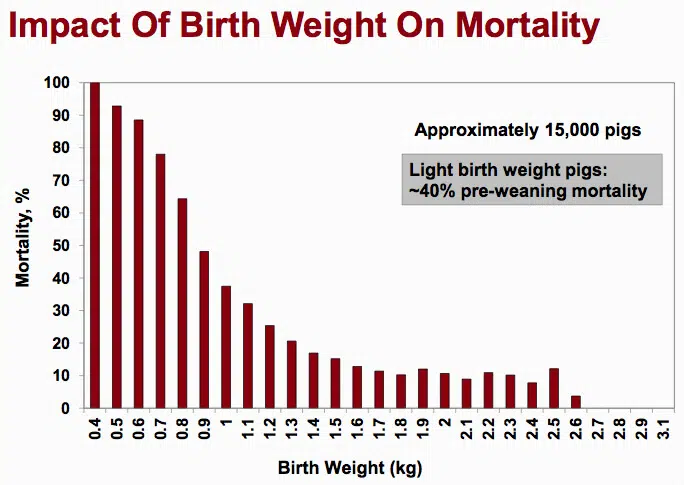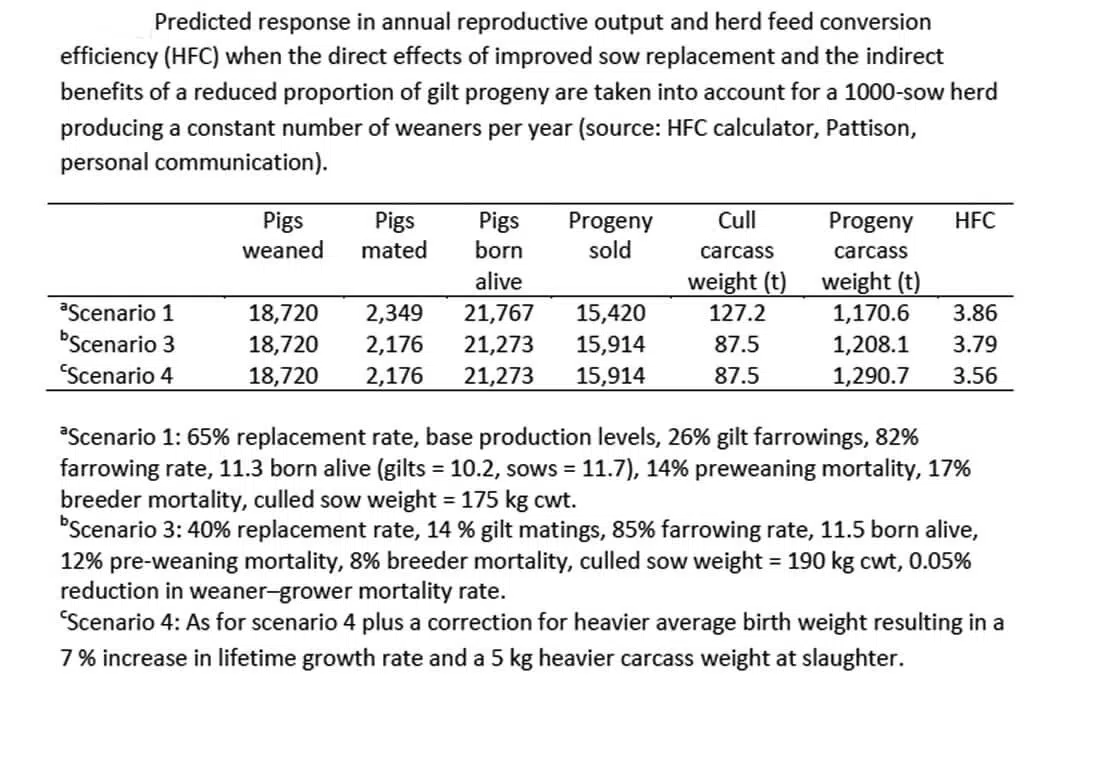Early culling linked to higher production costs | |||
| Early culling of sows adversely affects the overall productivity of the breeding herd by decreasing farrowing rate, potential litter size and progeny performance — traits linked to early parity sows, cautions Cherie Collins, PhD, research and innovation manager for Rivalea, Australia.
“A high turnover of early parity sows will have a negative impact on litter size,” she says. “You are culling them before they reach their maximum performance level.” The primary reason for culling early parity sows is reproductive failure, followed closely by lameness or locomotor issues. “But it is unclear how many sows that are culled for reproductive failure actually suffered some degree of lameness during lactation, which in turn reduced their feed intake,” Collins points out. It is well documented that feed consumption during first lactation is a critical component in sow longevity. It could be that animals culled for reproductive failure did not eat enough to meet their nutritional requirements during the previous lactation due to lameness, she says. With sow replacement rates of 55% to 60%, producers must utilize a higher proportion of gilts within the herd to reach mating and weaning targets. In direct costs alone, swine producers are feeding more females for fewer progeny. Link to production costs There are many drivers of profitability in the commercial swine herd. Looking at profitability through herd feed conversion (HFC) — feed consumed per unit carcass-weight produced — factors not only the sow, but also her offspring, into the equation.
Herd feed costs are influenced by factors including number of pigs weaned, number weaned per sow, days to slaughter, feed efficiency and feed wastage, while carcass tons produced takes into account progeny growth rate, progeny slaughter weight, mortality levels and sow cull weight. The rate of sow turnover within a commercial herd has both direct and indirect effects on HFC. The direct effects of sow turnover on profitability are associated with feed consumption and, therefore, feed costs. The sow herd accounts for approximately 20% of feed costs in commercial farrow-to-finish systems. A high sow turnover associated with reproductive failures or lameness increases the number of non-productive days that the sow consumes feed and also increases the size of the gilt pool consuming feed. Indirect costs associated with gilt progeny In addition to these direct effects, there are substantial indirect costs associated with a greater proportion of gilt progeny in the herd. When comparing gilt progeny to sow progeny, there are wide variations in performance. Gilt progeny are not only lighter at birth and weaning but have a lower rate of gain that follows them throughout the production cycle, Collins says. Gilt-litter progeny also have higher mortality and increased disease susceptibility (Figure 1).
Recent research conducted by the Australian Pork Cooperative Research Centre and others indicates that gilt progeny are about 200 g (0.44 lb) lighter at birth compared to sow progeny. Not only are they lighter, but investigators have demonstrated that their preweaning growth rates are 12% to 17% less than sow progeny. In other words, gilt progeny are on average 1 kg (2.2 lb) lighter at weaning and 6 kg (13.2 lb) lighter at sale (24 weeks of age). Studies evaluating the value of fostering gilt progeny onto multiparous sows to improve preweaning growth have demonstrated that these pigs continue to lag behind when compared to sow progeny (Figure 2). According to Collins, animals that are light at birth — less than 1.2 kg (2.65 lb) — will also be fatter, when compared to animals born heavier, at similar carcass weights. Piglets born weighing less than 1.2 kg (2.65 lb) also account for 40% of preweaning mortality (Figure 3). Higher disease susceptibility and medication rates can also be associated with gilt progeny. Studies show that while gilts produce adequate amounts of colostrum, the transfer of antibodies to their piglets may be compromised when compared to multiparous sows (Miller et al., 2009). Collectively, all of these seemingly small factors linked to gilt progeny have a significant effect on HFC due to their effects on mortality and sale weight; the effects are much greater, in fact, than the direct impact of sow feed usage on HFC, Collins says. Decreasing gilt progeny improves profitability
Building a durable female and supporting her through her first lactation are key to decreasing the current replacement rates of 55% to 60%, she continues. Swine producers must focus on sound feet and legs, optimal trace mineral nutrition for strong bones and claws, and environmental conditions that include housing and floors designed to prepare the gilt for a productive future in the sow herd. Production modeling demonstrates that reducing replacement rates to around 40% can improve HFC by as much as 0.30 points, she says (Figure 4). “I hear production managers say, ‘If a sow can’t wean me the same number of pigs as what a gilt can, well, she can leave the herd,’” Collins says. “But are they really taking into account the full cost and impact that early removal actually has on the herd?” From the US perspective Dr. Mark Wilson, swine reproductive physiologist at Zinpro Corporation, agrees with Collins on the importance of decreasing turnover in the sow herd. “We know that a sow must reach her fourth parity to realize her economic potential,” he says.
“By working to decrease lameness in the sow herd, we are able to increase the longevity of sows and, in turn, are able to reduce the number of gilts entering the sow herd in each breeding group,” he adds. When sow lameness is decreased and turnover reduced, swine producers are able to improve reproductive parameters including feed intake during lactation, weaning weights, number of pigs weaned and farrowing rates. However, the greatest performance enhancement results from decreasing the number of gilt litters with progeny that exhibit decreased grow/finish performance. According to Wilson, it has been well documented — and reinforced by Collins’ research — that gilt litters also have a higher risk of disease, morbidity and mortality. These cumulative effects have a tremendous impact on HFC. In the US market, every point change in HFC represents approximately 11 to 12 cents/cwt; if, as Collins’ research shows, this ultimately results in a 30-point change in HFC, the financial impact on profitability is substantial. For more information: Contact your Zinpro Performance Minerals representative or click here. | |||||||||||||||||
Chemuniqué empowers feed and food producers with the most innovative animal performance solutions, enabling our clients to consistently advance the efficiency of production.














